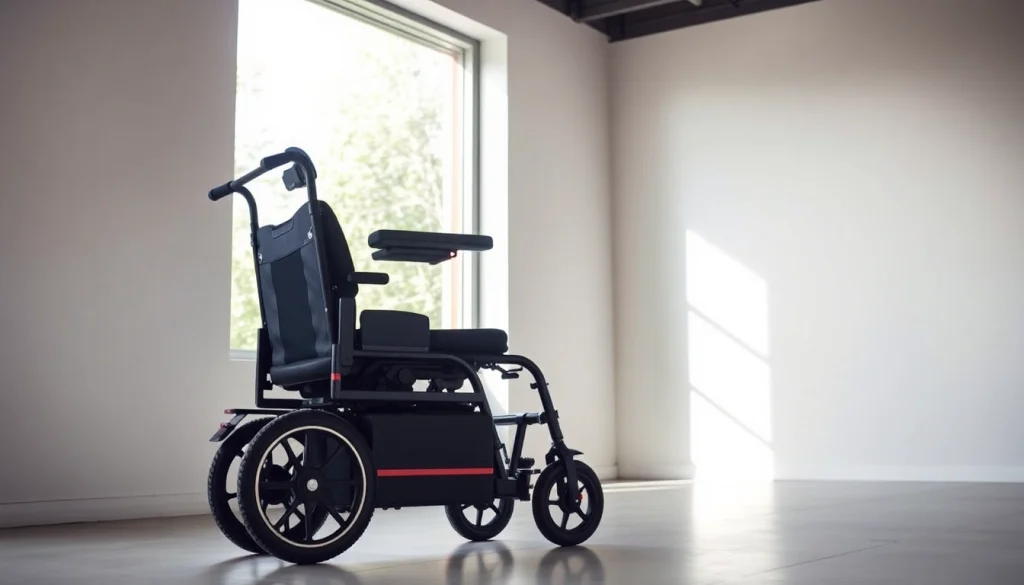Understanding Electric Wheelchairs
What is an Electric Wheelchair?
An electric wheelchair, also known as a power wheelchair, is a mobility device that allows individuals with limited mobility to navigate their environment with greater ease and independence. Unlike manual wheelchairs, which require physical effort to propel, electric wheelchairs are powered by electric motors, making them suitable for individuals who may not have the strength or endurance to operate a manual chair. Electric wheelchairs are equipped with controls, usually found on the armrests or through joystick-type interfaces, that give users the ability to move forward, backward, and turn with simplicity. They come in various sizes, styles, and configurations tailored for different needs and preferences. For more information on selecting the right electric wheelchair, it’s essential to understand their diverse features and characteristics.
Types of Electric Wheelchairs
Electric wheelchairs can be classified into several types based on their design and intended use:
- Standard Electric Wheelchairs: Designed for general use, these models are suitable for indoor and outdoor settings, offering essential features like stability and comfort.
- Heavy-Duty Electric Wheelchairs: Built to support larger users, these models often have stronger motors and reinforced frames, making them ideal for rough terrain.
- Portable Electric Wheelchairs: Lightweight and collapsible, these versions are designed for easy transport, making them perfect for travel and everyday use.
- Reclining and Tilt-in-Space Wheelchairs: These chairs offer adjustable seating positions, allowing users to change their posture throughout the day, which is beneficial for pressure relief and comfort.
- All-Terrain Wheelchairs: Equipped with robust wheels and suspension systems, these chairs can navigate uneven ground, making them suitable for outdoor and rugged environments.
Benefits of Using an Electric Wheelchair
The advantages of using an electric wheelchair are numerous and can significantly enhance the quality of life for users:
- Increased Independence: Electric wheelchairs enable users to traverse different environments without assistance, fostering a sense of autonomy.
- Reduced Physical Strain: For individuals with limited upper body strength, using a power wheelchair eliminates the need for physical exertion associated with manual wheelchairs.
- Enhanced Comfort: Many electric wheelchairs are designed with ergonomic features, providing better seating support and adjustments for extended use.
- Versatile Mobility: With features like variable speed control and advanced steering, electric wheelchairs offer smooth navigation in tight spaces, both indoors and outdoors.
- Customizable Features: Users can often add or modify components such as seating systems, control interfaces, and accessories to meet their specific needs.
Choosing the Right Electric Wheelchair
Factors to Consider Before Purchase
When selecting an electric wheelchair, it is crucial to consider various factors to ensure the chosen model meets your personal needs:
- Weight Capacity: Each model has a designated weight limit which must be adhered to for safety and performance. Always verify that the selected chair can accommodate your body weight comfortably.
- Size and Maneuverability: Consider the chair’s dimensions. If you plan to use it in narrow spaces or crowded environments, a compact model may be best.
- Battery Life: Evaluate how far you need to travel on a single charge and select a model that can support your day-to-day mobility needs without frequent recharging.
- Control Mechanisms: Many electric wheelchairs come with different control options—joysticks, touchpads, or sip-and-puff systems. Choose one that feels intuitive and easy to use.
- Terrain Capabilities: If your mobility needs involve outdoor use or navigating uneven ground, consider a chair with robust tires and a strong motor.
Assessing Your Mobility Needs
Understanding your mobility needs is critical in selecting the right electric wheelchair. Factors to consider include:
- Daily Activities: Assess how and where you will use the wheelchair most frequently. Will you navigate through your home, go to the grocery store, or utilize public transport?
- Health Conditions: Certain medical conditions may influence the choice of wheelchair. Consult with healthcare providers regarding specific requirements based on your health.
- Future Needs: Consider any potential changes in your condition that may require a more advanced wheelchair in the future; selecting a model that can grow with you could be a smart investment.
- Caring for Additional Needs: If you require specialized seating or support during use, factor these needs into your selection process.
Comparing Features of Various Models
While researching electric wheelchairs, it is essential to compare different models based on their features:
- Speed and Range: Look for chairs that offer a suitable balance between speed and distance per charge. The ideal model should get you where you need to go without compromising safety.
- Suspension Systems: Advanced suspension can greatly enhance comfort when navigating bumpy surfaces, making a smoother ride essential for outdoor travels.
- Seating Options: Adjustable seating systems can significantly improve comfort during long-term use. Ensure the selected model accommodates your specific posture needs.
- Portability Features: If you need to transport your electric wheelchair, consider features like lightweight materials, folding capability, and ease of disassembly.
- Warranty and Support: Evaluate after-sales service and warranty options available with your chosen model, as this can vary by manufacturer.
Maintaining Your Electric Wheelchair
Basic Maintenance Tips
To prolong the life of your electric wheelchair and ensure optimal performance, regular maintenance is essential. Here are some basic tips:
- Inspect Before Use: Regularly check for any visible signs of wear or damage, particularly on tires, electrical components, and seating.
- Routine Cleanings: Keeping the wheelchair clean can prevent the buildup of dirt and debris that may hinder its functionality. Use a damp cloth and mild detergent for surfaces, and avoid abrasive cleaners.
- Check Battery Health: Regularly monitor battery performance and ensure terminals are clean. A well-maintained battery ensures reliable operation.
- Tire Maintenance: Ensure tires are properly inflated and free from wear. Regularly inspect for punctures or other damage that could impair mobility.
Understanding Battery Care
The battery is a critical component of your electric wheelchair. Proper care ensures longevity and effectiveness:
- Charging Habits: Follow the manufacturer’s recommendations for charging. Avoid fully depleting the battery before recharging to prevent damage over time.
- Storage Conditions: If your wheelchair is not in use for an extended period, store the battery in a cool, dry place and charge it periodically to maintain its health.
- Battery Monitoring: Pay attention to diminishing performance, as this may indicate a need for replacement or maintenance.
Keeping Your Electric Wheelchair Clean
Cleanliness not only enhances the look of your electric wheelchair but also contributes to its functionality. Here are some cleaning tips:
- Regular Wipe Down: Use a soft cloth to wipe electronic components, and ensure they remain free of moisture to prevent electrical faults.
- Remove Debris: Regularly check and clean wheel wells and other areas prone to debris accumulation. This maintenance helps maintain performance and safety.
- Check Upholstery: If the chair has fabric upholstery, vacuum regularly to remove dirt and crumbs, and spot-clean any stains as necessary.
Accessibility and Safety with Electric Wheelchairs
Understanding Safety Features
As with any mobility device, safety is paramount when using electric wheelchairs. Familiarize yourself with the safety features that your model may offer:
- Braking Systems: Look for wheelchairs equipped with effective braking systems, including automatic brakes that activate when the joystick is released.
- Stability Control: Some models come with built-in stability controls to prevent tipping on uneven surfaces, essential for outdoor navigation.
- Lighting: Ensure your electric wheelchair has adequate lighting if intended for use in low visibility conditions or nighttime outings.
Navigating Different Environments
Electric wheelchairs must be able to adapt to various environments. Considerations include:
- Indoor vs. Outdoor Use: Choose a model that suits the environments you frequent. Indoor models may be smaller and more maneuverable, while outdoor models should be robust with better battery life.
- Public Spaces: Plan for accessibility in public places. Research the dimensions of doorways, ramps, and transport options you may encounter.
- Terrain Considerations: Ensure that your wheelchair is equipped to handle the surfaces you’ll navigate, such as grass, gravel, or pavement.
Legal Considerations for Electric Wheelchairs
Understanding the legal aspects surrounding electric wheelchairs is essential for safe and responsible use:
- Registration and Licensing: Investigate local laws regarding the registration of electric wheelchairs and whether they need to be licensed.
- Insurance Coverage: Check whether your insurance plan covers electric wheelchairs, which might include considerations for customizations or repairs.
- Operating Regulations: Familiarize yourself with regulations surrounding where electric wheelchairs can be used, including sidewalks, streets, and other public areas.
Future Innovations in Electric Wheelchair Technology
Emerging Trends in Mobility Devices
The future of electric wheelchairs is promising, with innovations continually emerging to enhance functionality and ease of use:
- Smart Technology Integration: Many modern electric wheelchairs now feature smart technology, allowing users to control their chairs via mobile apps, providing operational data and real-time monitoring.
- Augmented Reality Navigation: Future models may incorporate augmented reality systems for navigation assistance, helping users maneuver complex environments more effectively.
- Wearable Technology: Devices that sync with electric wheelchairs to monitor health metrics may reach the market, providing data that can help caregivers and users manage their mobility.
Integration with Smart Technology
There is a growing trend toward integrating electric wheelchairs with smart devices, offering numerous benefits:
- Remote Monitoring: Technology that allows caregivers to monitor the chair’s battery life and overall performance remotely enhances user safety and peace of mind.
- Customizable User Interfaces: Future electric wheelchairs may offer fully customizable interfaces that adapt to users’ preferences for operation, aiding ease of use.
The Role of User Feedback in Design Improvements
User feedback is integral to advancing electric wheelchair technology. Manufacturers are increasingly incorporating insights from users to refine designs and enhance usability. This collaboration results in:
- Enhanced Comfort and Ergonomics: By listening to user experiences, companies can address common discomfort issues, paving the way for more user-friendly designs.
- Improved Functionality: User-driven research leads to practical innovations, such as the development of specific features tailored to meet the unique challenges faced by individuals with mobility impairments.








